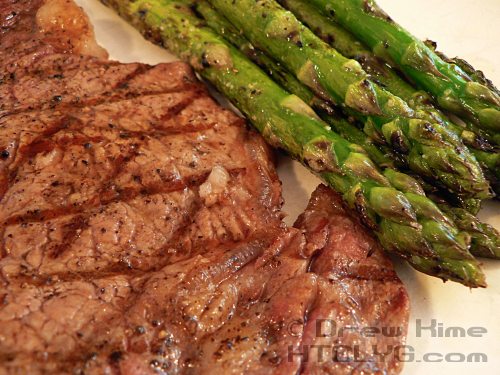Restaurants do things differently than you would in your kitchen. Sometimes that means they make something that you would never try. For instance they’ll spend a whole day making a stock, because they know they’re going to get a hundred orders for the special that night. But there are a lot more tricks that you can use. Today’s post is one of those tricks.
If you’ve ever been to a steakhouse and two people ordered steaks cooked differently — one medium-rare and one rare for instance — did you notice the size when they came out? The way they make sure all the meals for an order are done at the same time is to sort the uncooked steaks by thickness. Then they cook them all for the same length of time. The thicker ones are more rare, the thinner ones are more done. Pretty clever, huh?
The lesson to take from this is that the thinner the steak is, the faster it cooks. That means the perfect steak for grilling is thin enough that the moment the outside is charred the inside is done. The problem is Americans love the idea of a “thick, juicy steak.” So that’s how you’ll find all the good cuts in the store: thick.
Just one more reason to go to your local butcher. I went in and asked for four thin ribeyes. There weren’t any already in the display case, so he went back and cut them for me.
Bonuses from thin steaks:
- Those four probably would have been two at the regular cut size.
- They come up to room temperature much faster. And you should always let meat come to room temperature before cooking. The colder the center is, the more dried out the outside will be by the time the center is done.
- Higher ratio of surface area, so there’s more charred delicious goodness per bite.
Give the steaks a generous coating of kosher salt about 10 minutes before you plan to put them on the grill. The salt will draw out just enough moisture to get a great Maillard reaction going.
Then a coating of fresh ground black pepper.
Turn the grill up as high as it will go, lube it up with bacon fat, then lay the steaks out.
If it’s hot enough, the steak will sizzle the second it hits the grill. After about half a minute, turn the steaks about 45 degrees, but don’t flip them over yet. As soon as you see moisture start to collect on top, flip them over.
You should have those beautiful grill marks now. Repeat the process on the second side: quarter-turn after half a minute, then leave it just until you see moisture on the top.
If you have a cool spot on your grill, one of the steaks might not be as done as the others. (The one on the bottom right in that picture above.) If that happens, just swap places between the most-cooked and the least-cooked when you turn them over and everything will even out.
As soon as you see moisture on top, flip it one more time and let the juice drip down and flare up. A little good-old flame grilling is good for the soul. Reconnects you with your inner caveman. Scoop the steaks up out of the flame and get them to the table before they cool down.
And that’s it.
If you want to see a group of men totally blissed out, bring them a plate of these things and no silverware. Let them grab a steak and eat with their hands, with juice dripping off their elbows. [sigh] Good times … good times.

Ingredients
- thin-cut ribeye steaks
- kosher salt
- black pepper
- bacon fat
Instructions
Ask your butcher to slice some ribeyes thinner than usual, about three-quarters of an inch thick, definitely less than an inch. Allow them to come to room temperature before starting the grill.
Ten minutes before you're ready to cook them, while the grill is heating up, coat generously with kosher salt. After about five minutes, after the salt has drawn out some moisture, add coarse ground black pepper.
When it is smoking hot, brush the grill with bacon fat. Place the steaks on the grill, and they should start to sizzle immediately. After 30 seconds, rotate them about an eighth turn. This will give you intersecting grill marks at a 45-degree angle.
After another 30 seconds, flip the steaks over. (Each time you turn or flip the steaks, try to put them on a new section of grill that is still hot.) Another 30 seconds and another one-eighth turn for the grill marks.
As soon as juice starts bubbling through to the top surface of the steak, it's done.


















